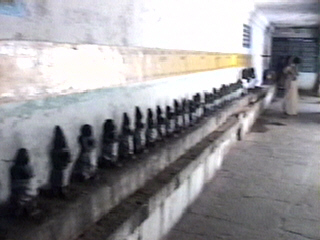|
|

Tiruvarur
Temples of Tamilnadu
History
The
origin of the shrine at Tiruvarur is steeped
in antiquity. Of the two major shrines in the temple, dedicated to Vanmikanathar
and Tyagarajar the Vanmikanathar shrine is the older one. It enshrines a Shivalingam
- prithvi lingam made of earth.
Two of the major legends surrounding the temple are associated with Manu Needi
Cholan and Muchukunda Cholan respectively.
Anecdotes referring to the lives of these legendary rulers (not attributable directly to
any of the Cholas of the Sangam period or the Vijayalaya
line of Cholas) are referred to in ancient Tamil literature such as Manimekalai
and Silappadikaram.
The vibrant tradition of worship that was present at this shrine during the period of the Nayanmars, is evident from the wealth of
the Tevaram hymns that are dedicated to Vanmikanathar
(Purtidamkondaar) and Tyagaraja (Veedhi Vitankar).

Both Tirugnanasambandar and Tirunavukkarasar of the 7th
century CE have sung of the glory of Tiruvarur. These hymns
describe the grandeur of the town, the music and dance that filled the city.
Tirunavukkarasar's hymns refer to Aaruran, Tirumoolattaanamudaiyaar
and Veedhi Vitankar (Tyagaraja) and describe the
grandeur of the Margazhi Tiruvadirai and Panguni
Utthiram celebrations at Tiruvarur.
Royal patronage meted out to this shrine is evident from the abundant
stone inscriptions that are seen in the temple complex.
It is evident that the original shrine of worship, possibly a brick and mortar structure
was replaced with a more rugged granite structure and added to, over a period of time.
The earliest inscriptions regarding grants to this temple date back to the period of Aditya
Chola of the later half of the 9th century CE and Parantaka Chola I (907-955
CE). The Achaleswarar shrine in the temple
complex was rebuilt of stone during the period of Sembian Mahadevi.
Rajaraja Chola I the best known of the Chola monarchs
built the Brihadeeswarar temple at Thanjavur
and endowed it with vast amounts of wealth. It is learned from records that forty four
dancers were brought in from Tiruvarur to render their service at the Thanjavur
temple. Raja Raja was a great devotee of Nataraja and Vitankar
(Dakshinameru Vitankar - an icon representing the Somaskanda
manifestation installed in a separate shrine at the Bhrihadeeswara temple
at Thanjavur).
There are inscriptions testifying to his son Rajendra
Chola's visit to the Tiruvarur temple, and his donation of a lamp in
commemoration of the visit, soon after the conversion of the brick built shrine into a
stone structure. Rajendra Chola is also associated with rebuilding the Tyagaraja shrine
at Tiruvotriyur in stone. Both Tiruvotriyur
and Tiruvarur are closely associated with the life of Sundaramoorthy
Nayanar.
Images of Rajaraja Chola and Rajendra Chola are housed in the Tiruvarur temple.
Inscriptions from the period of the Chola rulers that succeeded Rajendra Chola are
seen in the temple complex. Kulottunga Chola II extended great patronage
to the temple and instituted grants for carrying out several festivities in the temple on
a regular basis. Also are seen, inscriptions from the Pandya period, the Vijayanagar
rulers, the Nayaka period and the Maratha period.
The name Tyagaraja became associated with Veedhi Vitankar
during the period of Kulottunga Chola II (vide Muchukunda Sahasranamam). Several literary
works such as the Tiruvarur Puranam came to be written after
the 15th century.
The Maratha ruler Serfoji Maharaja of Thanjavur was
devoted to the shrine at Tiruvarur and he
performed the renovation and the Kumbhabhishekam of the shrine in the
year 1717. The great Karnatic music composer Mutthuswamy Deekshitar composed several
kritis in praise of Tyagaraja, Kamalambika and other
deities housed in the temple complex.
Another Kumbhabhishekam was performed in the temple in 1986 and the most
recent one in March 2001.
|
|
